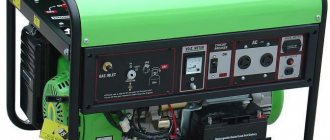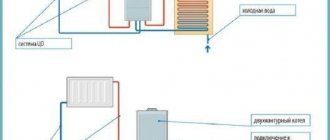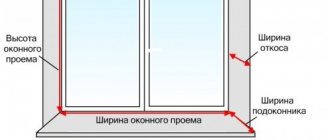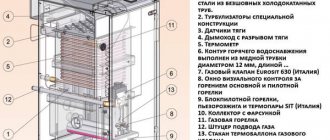From the author: Hello, friends! Home air heaters create warmth and comfort in the house when there is frost and cold wind outside. After installing a new heating system, apartment owners often do not know how to turn on the gas convector. Of course, you can study the instructions, but the best way is to see everything with your own eyes using a video or get information from experienced users. Additionally, you need to familiarize yourself with the safety precautions and operating rules of the device.
Flaws
All of the above belongs to the category of advantages of gas convectors. Next we will look at the shortcomings. All pros and cons are such only in the context of this article. For example, if we take the speed of acceleration of a car, then high engine power can be considered a plus, and driver safety and fuel efficiency can be considered a minus.
This is the case with gas convectors. The biggest disadvantage of this device is that you need to drill into the wall to install it. And not just make a hole, but a hole for a coaxial gas outlet. The gas outlet is a special tube in a pipe through which exhaust gases exit, and the fresh air necessary for combustion enters the convector through an external pipe. It is logical to assume that there should be a hole in the wall in the place where the convector is located, and if they are located under every window in every room, imagine how many holes there will be in your house! And these holes cannot be hidden or brought to one place. And remember another hole in the wall for gas supply. A vivid picture of a house appears before your eyes, shrouded in gas pipes and full of holes in the walls. Agree, not a very inspiring sight!
Let's imagine a living room with an area of 30 square meters with two windows. Using a standard heating system, a convector would need to be placed under each window. In the case of gas convectors, this option does not work. We will need to install one convector with increased power in a certain place on the external wall of the room, where there would be optimal conditions for supplying gas there and making a duct for exhaust gases. With this installation there will be no temperature balance in the room. It will be hot in one corner and cold in the opposite. For comfort, you need to place another low-power convector under each window, which immediately doubles the cost of the entire system and the aesthetics of the room. We conclude that this option is inferior to a conventional water heating system.
The gas convector has low inertia. In other words, it heats up very quickly and cools down at the same speed, which can be considered both a plus and a minus, it all depends on how the device is used. In a residential area, of course, this negatively affects the comfort of the temperature regime, but for a garage, workshop or shed, quick heating is a definite plus.
There is one more nuance in a gas convector, which can, in a certain case, be considered a plus or a minus. It has a combustion chamber in which the gas, burning, heats a certain body and a chamber, which then heats the air. For a long service life of the convector, it must use steel that is resistant to fading. It’s good if it uses just such a special steel. But in this case it will not be cheap at all. If it uses cheap steel, then the convector will very quickly fail due to corrosion, burnout, etc. Now, if in a convector the combustion chamber is made of 10 mm cast iron, then such a device will practically last forever.
Heater replacement
It is not difficult to repair convectors with your own hands if there are domestic heating elements inside. If they are open, then repairs can be made using the following method:
- Remove the spiral from the bar.
- Measure its length and wind a spiral of the same cross-section from nichrome wire.
- Place the spiral on the ceramic strips (put on ceramic safety beads).
- Place it back in its original place.
At the same time, we must not forget one feature of nichrome - when heated, the thread lengthens and sags, so during installation it must be slightly stretched to prevent dangerous contact with the metal parts of the body.
Closed types of heaters change in a similar way - the burnt-out spiral is removed from the hermetic glass flask, and a new one is inserted in its place
But first, it must first be washed in gasoline to remove the grease - only after this can you begin final assembly with all precautions
If a heating element is installed in the convector, then your task is to accurately determine its inoperability, and replacement is even easier than in other cases. A new heating element is installed in place of the burnt-out heater, followed by connecting the current-carrying wires.
Heating element repair
Design and principle of operation of a gas convector
How does a regular water convector work? This is the most common steel, cast iron, aluminum or bimetallic radiator connected to the heating system. Hot coolant enters the convector, after which the equipment begins to heat the atmospheric air. An electric convector works in approximately the same way, only instead of a coolant, electricity is supplied here, not through pipes, but through wires.
Gas convector device.
How does a gas convector work and what is this unusual device? A heating gas convector is an autonomous heating device that generates heat through a built-in gas burner. The resulting heat is released into the atmosphere, as a result of which the room is heated. But these convectors cannot be called completely autonomous - after all, they can also operate from main gas. Another thing is that such heating does not require laying pipes with coolant and installing a gas boiler.
Gas convectors for heating have a relatively simple design. Inside we will find:
- gas burner;
- closed (less often open) combustion chamber;
- heating control circuit;
- air heat exchanger;
- security systems.
All this is dressed in a pleasant-looking case. The equipment turns out to be compact, but a little bulky - after all, inside there is a full-fledged gas burner and an impressive heat exchanger.
The air heated in the heat exchanger tends upward, and cold air fills its place.
The operating principle of a gas convector is very simple - natural or liquefied gas enters the burner, ignites and heats the finned heat exchanger, and the combustion products are removed outside using a fan. When heated, the air rises and enters the room. It is replaced by colder air masses. Continuous convection is created, in which almost all the air in the room takes part.
The operation of the burner is controlled by a thermostat that analyzes the air temperature in the room. It is he who turns the gas burner on or off, maintaining the set temperature.
These devices are used to heat buildings for various purposes - these can be residential premises, small offices, utility rooms and much more. Compact gas convectors for dachas are also produced, with minimal dimensions and designed for heating small rooms. A common feature of all such convectors is that they heat the air in only one room - if you need to heat two or three rooms, you will have to buy two or three convectors.
Types of in-floor radiators
Let us immediately note that the installation of in-floor convectors in a screed does not depend in any way on its type. In this case, the operating principle of different heat exchangers is different. There are two main differences - this is the method of air circulation:
Convector design with natural circulation.
Radiators with natural circulation are a copper collector made of two pipes with aluminum fins, which are placed in a metal trough. In such batteries, air moves due to temperature differences. As you know, hot streams are lighter than cold ones, so they rise upward.
In convectors with forced circulation, air moves due to the operation of a built-in tangential fan. It looks like a wheel with curved blades. It works quietly, but there is still some noise. Trench convectors with a fan are connected to the electrical network and have a control unit with a thermostat installed.
The battery can be heated by the coolant liquid or by means of a heating element inserted into the collector tubes. Separately, it is worth highlighting universal in-floor convectors. In the photo above you can see that in appearance they do not differ from ordinary ones, the difference lies in the design of the collector. These heat exchangers can operate both in a two-pipe heating system and in a four-pipe system, which we will talk about a little later.
Installation recommendations
It is well known that the installation of a gas convector consuming main methane must be carried out by specialists from companies that have the appropriate permits. It is worth clarifying this somewhat generalized requirement: the issue is not installation, but connection to the gas supply network. This operation can indeed be performed by the above-mentioned workers in accordance with previously completed project documentation. This means that you can put the units in place with your own hands, but without connecting to the gas pipeline.
If you nevertheless decide to take bottled gas as an energy carrier, then the situation is simpler. Connecting propane heaters does not require any permits. However, it is strongly recommended to involve a specialist in this work, at least as a consultant. It will help you check the correctness and quality of the connections and carry out the first start-up of the unit.
Before installing a gas convector, you need to make a round hole of the appropriate diameter in the wall. Next, attach the device to the wall or floor according to the operating instructions. In this case, in some heater models, the external temperature sensor with a capillary tube must be moved from the transport position to the working position. After this, all that remains is to connect the fuel supply line to the inlet pipe on the device.
Connection to gas supply
This is the most important stage and must be taken very seriously. If you do not have special skills, it is advisable to entrust the work to specialists. Repairing gas convectors with your own hands is also unnecessary. This is for professionals.
The connection is made according to the following algorithm:
- Making a bend on a gas pipe. If there is a special outlet, you just need to screw the tap onto the pipe.
- Gas pipe supply to the convector. In this case, it is necessary to ensure that the fitting connection is perfect.
- When laying a pipe, it must be secured with clips at intervals of 1.0 m.
- Call a gas service worker to check the connections.
How to turn on a gas convector
Again, it is recommended to entrust the first start-up of the unit to a specialist. After he has completed the commissioning work, you can safely use the equipment yourself. The algorithm for turning on the convector is as follows:
- check the presence of draft, and then open the gas valve at the inlet of the heater;
- press and hold the adjustment knob on the valve;
- use the piezo ignition button to light the igniter;
- hold the handle for 10-15 seconds, then release;
- If the wick does not go out, slowly turn the handle and set the desired temperature. The main burner will light up automatically.
If your convector is equipped with a blower fan, a supercharger and electric ignition from batteries, then it starts automatically. You just need to plug in the device, open the gas tap and press the corresponding button on the front panel.
Switching procedure
To ignite the pilot burner, you need to move the main regulator from the “OFF” to “ON” position.
Press and hold the control knob for a few seconds until the pilot light comes on. Check to see if the wick lights after you release the control knob. If the light goes out, repeat the operation. To further understand how to turn on and operate the device, watch the video. Set the temperature control to the desired position - from 13 to 38 degrees. Each of the seven values corresponds to a specific indoor air heating temperature. The gas convector can be left in standby mode when only the wick is lit and the main flame is extinguished. To turn off the device, just press the “OFF” button.
Attention! After the end of the heating season, the gas supply to the device should be completely shut off. To do this, close the valve on the gas pipeline.
What gas is used
In the original version, the convectors were designed to consume mains gas, which created a false assumption that the installation used only natural gas.
But when using special transition kits, it is very easy to convert it to liquefied fuel. Some device models are already designed for the possibility of transition.
The use of bottled gas has several nuances, including:
- It is economically inefficient to work on liquefied fuel, since the cost is equal to the price of electricity if correctly recalculated.
- There are strict requirements for the installation and operation of equipment. It is better not to deal with the installation process yourself, but to entrust the arrangement to specialists.
Good to know: can the thermostat be repaired?
A number of signs indicate a thermostat malfunction.
Namely:
- Lack of clicks;
- Moreover, the convector works and heats up;
- It began to heat up as much as possible, without reacting to the turns of the temperature regulator.
There is no point in taking actions to repair it, because... they have a closed body. It is almost impossible to open the thermostat housing without breaking it. In addition, they are available at any hardware store.
Gas convectors technical characteristics or what they are
Essentially, we have before us a simple heating device consisting of a heat exchanger in an attractive housing and a gas burner.
Construction of a gas heating battery
An excursion into history: back in the 19th century, rooms were heated and illuminated with gas, and even in those days this heating method was cheap, convenient and practical. But then the heating systems and lighting ran on acetylene and were ordinary gas jets, i.e. open burners. Such burners required adjustment to minimize the volume of soot. In addition, combustion products exited the room through a common single ventilation. At the same time, oxygen was consumed to maintain combustion from the volume of the room.
Gas heating convectors have several pleasant innovations, which, ultimately, make them modern heating batteries from rarities:
- The gas flow rate is automatically adjusted, which means more economical gas consumption. A simple thermostat turns off the burner or switches it to maintain the flame when the required temperature is reached. If it becomes 3° less, then the fire lights up again.
- The flame heats the heat exchanger, and not the actual air in the room.
- For most models of modern gas heaters (convectors), air to support combustion comes from the street. And combustion products are removed there too. In this case, it is not a fan that is used, but a pipe in a pipe, the so-called. “coaxial duct”, which is discharged through a different opening.
These are closed-type gas heating convectors. However, there are also so-called open-type gas heating batteries that take air from the room and discharge combustion products into the general ventilation system. Such gas convectors are in great demand due to their easy installation: for heating you just need to connect the battery to the gas source.
Open type gas heating appliance
Fuel for operating a gas heating appliance
You should not think that gas heating radiators can only be placed in places with a natural gas supply from the main gas pipeline. In essence, the operating principle of a gas convector is to use such gas. But manufacturers also produce special adapters that allow the gas convector to operate on liquefied gas, i.e. connect the heating device to a regular cylinder.
Gas convectors using natural gas
Features of a gas heating convector: pros and cons
How convenient and profitable is heating with a gas battery? Does it have any disadvantages? First, let's look at their advantages:
- The cheapest way to heat both an apartment and a house. However, if gas convectors using bottled gas are used, heating costs are almost equal to those of an electric boiler. And less profitable than a solid fuel boiler or heat pump.
- The efficiency of such heating devices can reach up to 97%, i.e. they are economical.
- They can operate at any temperature, even at -50°C.
- There is no combustion of oxygen in the air of the room. Since air is used for combustion, which comes from outside the house.
- Service life - at least 20 years.
- Installation of a gas convector is simple and can be done with your own hands. See below for more details.
- Autonomy: you can easily heat several rooms of the house or just one room.
As with the operation of any gas equipment, batteries (convectors) must be used in compliance with strict safety measures, since the gas is explosive!
When using gas convectors using bottled gas, the saving effect from using such heating batteries is reduced to zero. Gas batteries are only useful when there is no electricity. At the same time, the process of replacing the cylinder with an interval of 1 to 4 days may seem quite tedious.
More cons:
- Gas radiator heating cannot be used to heat water.
- Quite limited thermal conductivity - 2-7 kW (for most models).
- Despite their rather beautiful appearance, they are quite large in size, so they are not easy to disguise.
- Since this equipment runs on gas, its installation and connection requires obtaining permission from a special gas service.
Conclusion
To summarize, I would like to note that gas heating convectors are advantageous to install in small rooms of a summer house, garage or as an addition to a city apartment. For heating private houses with a large area, a gas boiler and liquid radiators are more suitable.
Mounted units.
Did you like the article? Subscribe to our Yandex.Zen channel
Construction of gas convectors
Let's consider the device of a gas convector. 1. Body. Provides device protection. Usually made of durable metal and coated with a special protective paint, which is resistant to temperature changes and protects the body from corrosion. 2. Heat exchanger. The task of this structural element is to heat the maximum amount of air as quickly as possible. For these purposes, the heat exchanger is made finned. Due to constant contact with gas, it is mounted from high-strength steel or cast iron and is also coated with high-temperature paint. 3. Gas burner. It is located inside the housing and consists of a pilot burner to which an electrode is attached to ignite the gas using a discharge. After this, the main burner is ignited. 4. Smoke exhaust system. There are open and closed types. 5.Thermostat. When the room air is heated to a predetermined temperature, the thermostat is activated and the gas supply is at the minimum level required only to maintain the desired temperature. 6. Automation system. Responsible for safety and at the first problems in the operation of the convector, it instantly turns off the device.
Different sizes of convectors
Precautionary measures
The use of household appliances requires compliance with safety precautions. Be careful and listen to the advice of manufacturers:
- You cannot use a convector that has a damaged viewing window,
- if the device goes out spontaneously, do not re-ignite it earlier than after 3 minutes,
- To prevent burns, the convector is protected with a protective grille.
It is strictly prohibited:
- dry things on a running appliance,
- turn the device on and off for children and people with limited legal capacity,
- operate the device with the outer casing removed,
- repair the device yourself,
- place flammable objects at a distance of less than 1 m from it,
- leave it on if signs of a gas leak are detected.
If there is an unpleasant odor in your home, take immediate precautions:
- turn off the gas supply,
- extinguish all sources of open fire,
- do not touch switches and mobile phones,
- ventilate the room
- urgently call the emergency gas service,
- Contact a gas convector service center.
Device
Gas convector operation diagram
The design of the gas convector is extremely simple, it contains:
- the combustion chamber;
- gas-burner;
- automation unit (Eurosit);
- a heat exchanger that forms the outer part of the combustion chamber;
- coaxial chimney.
The combustion chamber is of a closed type. Air from the street is supplied into it and combustion products are discharged there. There are a small number of models of convectors with an open burner, but it is better to avoid such devices, as they quickly burn oxygen into the room and saturate the air with CO2 and other combustion products.
Combustion chamber and heat exchanger material:
- steel;
- cast iron.
A steel camera is lighter and cheaper. A convector with a steel filling is 10-15 kg less in weight than with cast iron. However, even if the manufacturer used special heat-resistant steel, it still burns out over time and the service life of such a device is lower.
The cast iron combustion chamber has an almost unlimited service life; it is sensitive only to sudden temperature changes. What causes microcracks in the material. Otherwise, cast iron is resistant to corrosion, does not thin out under the influence of open fire and has a high heat capacity, which is rather a positive characteristic for a heating device.
The convector uses a simple-shaped single-module burner that ensures even combustion over a distributed area
It is important that the flame on each nozzle is small, and the gas mixed with air in a certain proportion burns completely without residue
Gas convectors are designed for the use of natural gas in accordance with GOST 5542 low pressure 1274 Pa. Often convectors simultaneously support the installation of a liquefied gas cylinder, which is supplied through a nozzle and a reducer. Mechanical automation, more often the well-proven EuroSit, is responsible for controlling the gas supply, adjusting the output power and controlling the temperature in the room.
The chimney is presented in the form of a coaxial pipe, in which a pipe of a smaller diameter is inserted into a pipe of a larger diameter, forming two separate channels. Combustion products are discharged through the internal channel, and fresh air from the street enters through the gap between the pipes to maintain gas combustion. It is assumed that the convector is installed near the wall bordering the street. The chimney immediately exits to the outside of the building through a prepared channel. The shorter the chimney length, the better.
Supercharged
Heating of the heat exchanger occurs quickly and actively, its temperature can reach 600°C, although more often the heat exchanger area is designed so that the convection flow is sufficient to maintain a much lower temperature of 60-120°C.
One of the options to actively and quickly remove heat from the heat exchanger, and at the same time quickly warm up the heated room, is to use a supercharger, a fan that can quickly drive a large volume of air through the convector.
This approach is appropriate, for example, for heating a utility room, industrial or construction area, country house or garage. Where it is mostly cold, and it is necessary, if necessary, to quickly create comfortable conditions for people. If the convector is used as the main heat source, the fan will be partially occupied only at the beginning of the process, until the air is heated, and then it will turn off and not be used.
Separately, the most compact convectors should be mentioned. They use a fan constantly. The heat exchanger area is reduced to reduce the weight and dimensions of the device, and to achieve the required thermal power, a fan is needed to have time to remove heat from the combustion chamber.
Installation Rules
Once the convector has been purchased, it can be installed. Before you do this, you will need to have a certain set of tools:
- drill;
- spatula;
- pipe cutter;
- wrenches and adjustable wrench;
- screwdrivers;
- perforator;
- gas tap;
- special silicone;
- self-tapping screws;
- dowels
It is necessary to choose a place where it will be located. It is best to do this in accordance with GOST. According to it, installation must be carried out under a window. After this, you should prepare the room. That is, the surrounding space around the installation site must be covered. The installation is done according to this algorithm.
- It is necessary to determine the hole for the gas pipe to enter. It is necessary to leave a gap for the pipe and fitting.
- We make a through hole according to the size of the exhaust pipe using a hammer drill.
- We make holes for the fasteners on which the heater will be mounted, and hammer the dowels in there.
- We connect the device to the exhaust pipe and seal the joint with special silicone.
- We fix the heater to the wall using self-tapping screws.
- We seal all holes using foam to prevent cold air from entering the room.
pros
Economic indicator. Electric convectors are cheaper. But a special advantage of gas convectors is their reduced operating cost. For example, popular models with cast iron heat exchangers and a power of up to 3 kW cost twice as much as electric ones with similar parameters.
However, this difference is very quickly covered during operation. The fact is that, according to calculations, the cost of heating the same area of a room when using natural gas is sometimes 10 times lower than when using electricity. The price of a cubic meter of gas and a kilowatt of electricity are approximately similar. But savings are achieved due to the fact that only 0.1 m3 of gas is needed to produce 1 kW of thermal power. All these statements are valid only when a gas convector is connected to a main pipeline and natural gas is used.
Work on liquefied gas. A gas convector can be easily converted to bottled gas. This makes it possible to use such heating devices in areas where there is no electricity or where it is supplied intermittently. But from an economic point of view, convectors using liquefied (cylinder) gas are also economically imperfect, like electric ones.
Lack of coolant. This is a noticeable plus in the absence of running water in the rooms where heating devices are planned to be connected. This is also an excellent factor if during the frosty season you need to leave the building for a long time - the water in the convector will not freeze, since there is none there. This is a good option, for example, for cottages, garages, utility rooms.
Environmental friendliness. The gas convector does not burn oxygen and is safe if all operating standards are observed.
Temperature adjustment. Such convectors have the full possibility of easily setting the required temperature and adjusting it.
Types of devices
A gas air heater, like other heating equipment, is an excellent option for creating a comfortable temperature regime. Depending on the place of use, they are made in two types:
- Stationary are gas heaters using natural gas for the home; they are connected to the appropriate mains (they can also be powered by a liquefied gas cylinder); a prerequisite for installing such equipment is the presence of a chimney that ensures the removal of combustion products and the flow of air. For ease of use, models are available equipped with replaceable nozzles that provide various ways to connect the device.
- Portable devices are not able to provide full heating of a residential building or an entire apartment, so they are used in dachas, in the garage, to maintain heat in the room. Due to their mobility (small size and weight), the devices can be placed in any room and, if desired, moved to other rooms. Such heaters operate on liquefied gas (connected to a household cylinder).
In this video we will look at a gas heater and its capabilities:
For ease of placement, wall, floor and ceiling models are available. The combustion chambers also differ. The closed type of chamber is more practical to use, since the air required for combustion comes from the street and the products of work are discharged there.
Despite the variety of models produced, gas heaters have the same components. The main components of the devices are:
- Frame.
- Burner.
- Heater.
- Heat exchanger.
The most common models of gas heaters are:
- Infrared heaters are equipped with metal or ceramic emitters that, when heated, emit heat (infrared waves), which heats the objects in the room, rather than the air.
- Catalytic models are considered safe. During operation, there is no combustion process itself; the release of thermal energy occurs as a result of a chemical reaction. The fuel supplied to the catalytic panel is oxidized, resulting in the release of heat. The room is heated using both convection and infrared or mixed types.
- Convection heaters are the simplest units. As a result of gas combustion, finned radiators heat up, from which heated air rises, and cold air falls in its place and heats up.
When used correctly, these devices will be reliable assistants capable of quickly creating a comfortable thermal regime in any room, even in the absence of electrical energy.
The main causes and ways to eliminate refrigerator crackling
Why there is a cracking sound in the refrigerator, only people who understand the device will answer with accuracy. Extraneous sounds during operation of the refrigerator do not always indicate its breakdown. In some cases, you can eliminate them yourself. The main thing is to understand the factors that provoke the appearance of crackling and clicking sounds.
If there is a strong, continuous sound that is unbearable, if the refrigerator is new, contact the seller; if not, contact the service center.
Clicking noises during operation
There are several reasons for the appearance of clicks during operation of equipment.
- Compressor operation (the device is designed to maintain the required temperature, while the noise level is indicated in the device passport).
- Cracking of the plastic casing due to temperature changes (when the optimal mode is set, the sound stops).
- Friction of elements.
- Circulation through the refrigerant pipes.
- When the motor turns on and off, the thermostat clicks (the volume depends on the model and brand of freezing equipment).
- Uneven surface (clicks occur due to subsidence or malfunction of the adjusting supports).
- Thermostat malfunction (the equipment does not freeze during operation, the refrigerator must be turned off before a specialist arrives so as not to damage the engine).
- Failure of the motor-compressor (when turned on, the rear part of the equipment creaks, crackles, the engine makes a hum and an unpleasant odor is felt. In this case, it is also worth unplugging the unit from the outlet and waiting for the technician to arrive).
- Loose compressor mount (there is a loud clicking sound before disconnecting from the power supply. The problem can be fixed by adjusting the springs supporting the compressor).
- Burnout of the evaporator heating element (the resulting ice creates a load on the operation of the compressor).
- Contact of parts with motor tubes.
- Wear of compressor shock absorbers.
If this has not been observed with the refrigerator before, then in this case there is a possibility that the temperature control device will soon need to be changed. Call a specialist to confirm or deny this point.
If, despite the extraneous noise, the refrigerator and freezer continue to freeze and the light inside is on, then there is no serious damage.
It crackles but doesn't work
The main reasons include the following factors.
- Failure of the thermostat (when the refrigerator is turned on, this unit gives a command to the control module that drives the motor. Starting the thermostat is always accompanied by a crash, but if the equipment does not start working, then the problem is 90% in the thermostatic relay).
- Failure of the start-up relay (the equipment does not turn on, there is no light and a click is heard).
- Failure of the motor-compressor (when connected to power, a click occurs, the motor starts for a few seconds, hums loudly and stalls).
- Low voltage in the network (after turning off the engine does not start for a long time, and the refrigerator itself crackles).
If you discover any breakdown, the best option is to contact a service center. The cost of repairs varies depending on the severity of the damage and your region of residence.
If you find it difficult to determine why the refrigerator is cracking during operation, consult a specialist. It is better to call a specialist to your home so that he can perform diagnostics to determine the exact cause.
The lack of necessary knowledge and diagnostic tools makes it much more difficult to identify the true cause of extraneous noise.
Internal layout and materials
As mentioned above, the main task of the heating system - heating the air - is solved by a heat exchanger. Therefore, the choice of its configuration, size and material of manufacture must be carried out especially carefully. In the first two points (configuration and size) there is a unity of opinion.
Thus, the most effective is the S-shaped position of the tubes in a ribbed radiator, which ensures uniform heating of the metal and rapid release of the body to the passing flow. The dimensions are set in proportion to the power of the device. Manufacturing materials are more difficult.
The buyer or system assembler will have to choose from several options, each of which has its own advantages and disadvantages.
The most popular are:
- Steel is cheap, heats up quickly, but also cools down quickly. It is susceptible to corrosion, and therefore is relatively short-lived, and gradually loses efficiency during operation.
- Cast iron is another budget solution, but more promising than steel. Cast iron is fragile, so products made from it should be installed carefully, and the large specific gravity of the material imposes additional requirements on the reliability of mounting the system on the wall. Among the advantages of cast iron is its high heat capacity, that is, the ability to release accumulated heat for a long time even after the burner is turned off.
- Aluminum alloys – due to their low weight, high strength and chemical stability, are capable of functioning reliably for a long time. In terms of heat capacity, they are practically not inferior to cast iron, but they are an order of magnitude more expensive.
- Copper – provides maximum heat capacity, is practically not subject to corrosion, can withstand temperature and pressure changes well, and is easy to mold and install. However, you will have to pay well for such versatility - copper heat exchangers are the most expensive offered on the modern market.
Having analyzed the advantages and disadvantages of each material, we can come to the conclusion that in industrial gas convectors, heat exchangers made of cast iron and aluminum alloys are preferred, since they provide the optimal price-quality ratio.
In home-made devices, it is better to give preference to aluminum alloys or copper as they are more reliable and not so demanding on the skills of the assembler.
Another dilemma to be solved is whether the system is equipped with an open or closed combustion chamber.
- The open chamber takes cold air directly from the room, warming it up and removing combustion products into the external environment. However, if there is an installation error, an insufficiently efficient exhaust hood, or in a poorly ventilated room, there may be a lack of oxygen and an increase in the concentration of carbon monoxide. It is recommended to install a convector with an open combustion chamber exclusively in non-residential premises.
- The closed chamber forces atmospheric air inside through a coaxial pipeline. Combustion products move along it in the opposite direction, which preheat the clean air through the pipeline wall. This system is more reliable and safer, it is compact and easy to install. However, a closed chamber is not without certain disadvantages - its operation requires electricity, which is not always convenient in suburban conditions, in addition, the price of a convector with a closed burner is always higher.
And the last feature, which was already mentioned above, is the presence of a fan heater. Everything is simple here - the more powerful the fan, the faster the heated air will reach remote rooms and walls, ensuring a more uniform distribution of heat. And as the fan power increases, the noise level and electricity consumption increase. In powerful devices, the fan also prevents the heat exchanger from overheating, thereby extending its service life.
Features of choice
When choosing a gas convector model, you must take into account its operating conditions. Among others, the area of the room and the required temperature for heating should be highlighted. The described heating devices have additional features, including:
- circulation method;
- thermal power;
- drawing method;
- installation option;
- heat exchanger material.
As for the first factor, circulation may be absent or provided by a fan heater
Convectors can be wall-mounted or floor-mounted, sometimes this is important if the room area is limited. The heat exchanger can be based on cast iron or steel
As for the installation location, wall convectors are more practical. They take up little space and are usually installed near the window, creating a thermal curtain between the cold and warm zones. However, such devices should be quite light so as not to create additional load on the wall. Such devices are limited in thermal performance, which does not exceed 10 kW.
If it is necessary to heat a larger area, floor-standing equipment is selected, which usually has large dimensions and significant weight. The cost of wall-mounted and floor-standing units is approximately the same with similar capacities.
Nuances of installation and operation
Open type portable gas heaters are not recommended for use in bedrooms, bathrooms or hallways. Some models specify the minimum room size and mandatory ventilation requirements for heating appliances. The installation of gas equipment must comply with the state standard regarding the safety of gas installations.
Basic requirements for safe installation of a gas convector:
- It is prohibited to place devices in fire hazardous areas. The heater is placed under the window.
- The chimney pipe must be mounted externally and equipped with an outlet.
- Installation, dismantling, adjustment and commissioning of gas equipment is carried out only by certified Gorgaz specialists.
- After installation work is completed, commissioning work is carried out.
- Before the first start-up, open the gas inlet valve and check all joints on the gas line with a brush and soap solution.
- A piezo igniter is started to ignite the gas. It is possible that during the first hours of operation of the installation there will be a smell of burning oil due to the burning of the walls of the combustion chamber; in the future, the operation of the convector should be odorless.
Gas convector Hosseven HDU-5 DK
Purpose
The convector is designed to run on natural gas for heating premises for various purposes. In this case, combustion occurs in a closed chamber, air is supplied from the street and combustion products are discharged there. The heat released during fuel combustion is transferred to the combustion chamber body and heat exchanger, and then to the indoor air. Due to rapid heating, the air rises, making room for colder air, maintaining an active convection process throughout the room.
A gas convector heats the air faster and more actively than its electric counterparts or, especially, converter-type radiators for a water heating system. This is due to the higher surface temperature of the heat exchanger and the increased rate of heat transfer from the combustion chamber.
A gas convector is an excellent solution in the following situations:
- The main heating of a small room or house with one or two adjacent rooms.
- As a replacement for a solid fuel stove, which was previously used to heat the house.
- For quick warming up and maintaining a comfortable temperature in the garage, utility room, or small country house.
- As an addition to the central heating system in rooms where installing a water radiator is difficult (basement and semi-basement, attic, veranda, etc.).
- For heating greenhouses.
As a replacement for main heating, a gas convector is only suitable for small houses or individual rooms. The efficiently heated area is easily calculated based on the available power models of gas convectors. Devices with a power of 2.5-6 kW are more often found on sale, less often up to 12 kW. In the first case, the convector is enough to heat a room up to 50 m2. The most powerful models are in demand only for industrial and public premises with an area of up to 100 m2.











